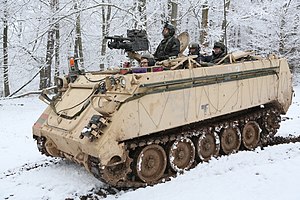
Back إم-113 Arabic M113 Azerbaijani M113 BS M113 Catalan M113 Czech M113 Danish M113 German M113 Spanish M113 Estonian ام۱۱۳ Persian
| M113 | |
|---|---|
 A U.S. Army M113-OSV of 1st Battalion, 4th Infantry Regiment, provides overwatch while conducting recon operations during exercise Allied Spirit at the Joint Multinational Readiness Center in Hohenfels, Bavaria, in 2015. | |
| Type | Armored personnel carrier |
| Place of origin | United States |
| Service history | |
| In service | 1960–present |
| Used by | See Operators |
| Wars |
|
| Production history | |
| No. built | ≈80,000 (all variants)[2] |
| Variants | Numerous, see text |
| Specifications | |
| Mass | 12.3 tonnes (13.6 short tons; 12.1 long tons) |
| Length | 4.863 metres (15 ft 11.5 in) |
| Width | 2.686 metres (8 ft 9.7 in) |
| Height | 2.5 metres (8 ft 2 in) |
| Crew | 2 |
| Passengers | 11–15 passengers |
| Armor | 5083 aluminum alloy 28–44 millimeters (1.1–1.7 in)[3][4] |
Main armament | M2 Browning machine gun |
Secondary armament | Varies (See text) |
| Engine | Detroit Diesel 6V53T, 6-cylinder diesel engine 275 hp (205 kW) |
| Power/weight | 22.36 hp/tonne |
| Suspension | torsion bar, 5 road wheels |
Operational range | 480 km (300 mi) |
| Maximum speed | 67.6 km/h (42.0 mph), 5.8 km/h (3.6 mph) swimming |
The M113 is a fully tracked armored personnel carrier (APC) that was developed and produced by the FMC Corporation. The M113 was sent to United States Army Europe in 1961 to replace the mechanized infantry's M59 APCs. The M113 was first used in combat in April 1962 after the United States provided the South Vietnamese army (ARVN) with heavy weaponry such as the M113, under the Military Assistance Command, Vietnam (MACV) program. Eventually, the M113 was the most widely used armored vehicle of the U.S. Army in the Vietnam War and was used to break through heavy thickets in the midst of the jungle to attack and overrun enemy positions. It was largely known as an "APC" or an "ACAV" (armored cavalry assault vehicle) by the allied forces.[5]
The M113 was the first aluminum hull combat vehicle to be put into mass production. Much lighter than earlier similar vehicles, its aluminum armor was designed to be thick enough to protect the crew and passengers against small arms fire, but light enough that the vehicle was air transportable and moderately amphibious.
In the U.S. Army, the M113 series have long been replaced as front-line combat vehicles by the M2 and M3 Bradleys, but large numbers are still used in support roles such as armored ambulance, mortar carrier, engineer vehicle, and command vehicle. The U.S. Army's heavy brigade combat teams are equipped with approximately 6,000 M113s and 6,724 Bradleys.
The M113's versatility spawned a wide variety of adaptations that live on worldwide and in U.S. service. These variants together currently represent about half of U.S. Army armored vehicles. It is estimated that over 80,000 vehicles in the M113 family have been produced and used by over 50 countries worldwide, making it one of the most widely used armored fighting vehicles of all time.[6]
M113 production was terminated in 2007. The Army initiated the Armored Multi-Purpose Vehicle (AMPV) program to search for a replacement. In 2014, the U.S. Army selected BAE Systems' proposal of a turretless variant of the Bradley Fighting Vehicle to replace over 2,800 M113s in service.[7] Thousands of M113s continue to see combat service in the Israel Defense Forces, although by 2014 the IDF was seeking to gradually replace many of its 6,000 M113s with the Namers,[8] and with the Eitan AFV in 2020.[9]
- ^ UN Mission in the Central African Republic MINUSCA (3 May 2012). "BF1V3726". flickr.com. Archived from the original on 10 October 2017. Retrieved 29 October 2017.
- ^ "BAE Systems M113 Vehicles History". United Defense. Archived from the original on 7 January 2010. Retrieved 20 May 2010.
- ^ "M113 Armored Personnel Carrier". Inetres. Archived from the original on 2 December 2005. Retrieved 20 November 2005.
- ^ "M113A2 APC". First Division Museum. Retrieved 4 August 2020.
- ^ Starry p. 73/Dunstan p. 107.
- ^ "M113A3 FAMILY OF VEHICLES" Archived 8 August 2008 at the Wayback Machine, BAE Systems
- ^ McLeary, Paul (23 December 2014). "Army Awards AMPV to BAE Systems, Future Fights Loom". Army Times. Retrieved 3 February 2022.[permanent dead link]
- ^ Ya'alon approves addition of 200 advanced APCs for the IDF Archived 3 March 2016 at the Wayback Machine Yossi Yehoshua Published: 09.22.14
- ^ "Elbit to provide Iron Fist for IDF's Eitan AFV in $31m. deal - The Jerusalem Post". 7 January 2020.